| |
|
|
|
|
| |
|
|
|
|
| |
|
|
|
|
| |
|
MERIT
Fair 2009
|
|
|
| |
|
Overview, Project Abstracts, Presentation Slides & Posters, & Research Papers |
|
|
| |
|
Friday, August 7, 2009 |
|
|
| |
|
|
|
|
| |
|
|
|
|
| |
|
Some of the MERIT Fair 2009 Participants
(click on photos to enlarge)
|
|
|
| |
|
The MERIT Fair is held
at the end of the summer to showcase the research conducted by the
undergraduate students during the summer. This forum provides the BIEN students
with the opportunity to present their work to the wider public.
Their efforts are subjected to scrutiny form a panel of judges selected
from academia, industry, and government laboratories. Prizes were awared for best
over all project, runner-up for best project, and best technical report. |
|
|
| |
|
|
|
|
| |
|
MERIT
Fair 2009 Prize Winning Projects |
|
|
| |
|
|
|
|
| |
|
|
|
|
| |
|
Biosystems Internships for Engineers (BIEN) |
|
|
| |
|
|
|
|
| |
|
|
|
|
| |
|
BIEN Project Abstracts, Technical Reports, and Presentation Slides |
|
|
| |
|
|
|
|
|
|
The Neural Representation of Auditory Modulations Relevant to Speech
Marisel Villafañe-Delgado (University of Puerto Rico Mayagüez Campus)
Nicholas Asendorf (University of Maryland at College Park)
Mentors:
Prof. Jonathan Simon (UMCP),
Nai Ding (UMCP) and
Kai Sum Li (UMCP).
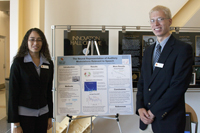 Magnetoencephalography (MEG) is a brain imaging technique that non-invasively measures neurally generated magnetic fields. Earlier MEG studies have focused on the neural responses to auditory signals amplitude modulated (AM) near 40Hz. Speech signals, however, contain a wide range of modulation rates, most of which are well below 40 Hz. Therefore we seek to characterize the modulation transfer function (MTF) of the human brain at AM frequencies much lower than 40Hz. To accomplish this, we use MEG to measure subjects’ brain responses to pure-tone carrier signals amplitude modulated at frequencies exponentially fluctuating between 3Hz and 60Hz. Analysis of the neural MEG data includes noise reduction, time-frequency analysis to characterize the MTF, and a comparison to the neural response to constant AM stimuli. Magnetoencephalography (MEG) is a brain imaging technique that non-invasively measures neurally generated magnetic fields. Earlier MEG studies have focused on the neural responses to auditory signals amplitude modulated (AM) near 40Hz. Speech signals, however, contain a wide range of modulation rates, most of which are well below 40 Hz. Therefore we seek to characterize the modulation transfer function (MTF) of the human brain at AM frequencies much lower than 40Hz. To accomplish this, we use MEG to measure subjects’ brain responses to pure-tone carrier signals amplitude modulated at frequencies exponentially fluctuating between 3Hz and 60Hz. Analysis of the neural MEG data includes noise reduction, time-frequency analysis to characterize the MTF, and a comparison to the neural response to constant AM stimuli.
Presentation Slides
Project Poster
Technical Report
|
|
|
|
|
Aqueous Electrical Charge and PH Sensitive Carbon Nanotube-Based Biosensors
Suchit Bhattarai (University of Maryland at College Park)
Mentors:
Prof. Romel D. Gomez(UMCP), and
Konrad H. Aschenbach (UMCP)
 Biomolecules such as nucleic acids, proteins and antibodies are electrically charged in solutions under specific buffer conditions. Systems that can detect the binding of such biomolecules in various solution conditions can have significant impact in portable diagnostics for biomedical and agricultural applications. This study focuses on carbon nanotube (CNT) based biosensor systems for detection of aqueous electrical charge and pH of solutions. Sodium chloride (NaCl) solutions of varying concentrations and three different pH solutions were used to study the biosensor chips’ responses. The sensitivity calibration factors have been determined. Biomolecules such as nucleic acids, proteins and antibodies are electrically charged in solutions under specific buffer conditions. Systems that can detect the binding of such biomolecules in various solution conditions can have significant impact in portable diagnostics for biomedical and agricultural applications. This study focuses on carbon nanotube (CNT) based biosensor systems for detection of aqueous electrical charge and pH of solutions. Sodium chloride (NaCl) solutions of varying concentrations and three different pH solutions were used to study the biosensor chips’ responses. The sensitivity calibration factors have been determined.
Presentation Slides
Project Poster
Technical Report
|
|
|
|
|
Robust Speech Recognition: Articulatory Information to Account for Coarticulation
John Robert Bailey (University of Maryland, College Park)
Kossivi Wody Edji (Montgomery Collegek)
Mentors:
Prof. Carol Espy-Wilson (UMCP) and
Vikram Mitra (UMCP)
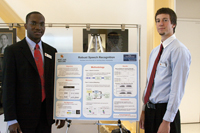 Current automatic speech recognition (ASR) systems assume piece-wise stationarity of the speech signal by representing speech as a concatenation of phones. As a result, varying degrees of temporal overlap in the production of neighboring sounds cannot be adequately modeled. Several studies have suggested that articulatory information can model coarticulation effectively. This research compares two types of articulatory information being considered for an ASR system based on gestural phonology. We investigate a methodology to estimate (1) tract variables which specify the degree and location of constrictions in the vocal tract (e.g., lip aperture) and (2) the x- and y-coordinates of pellets (transducers) placed on various articulators (e.g., the coordinates of the upper and lower lips). In our first task, we use recurrent neural networks that predict the articulatory information from the speech signal and compare whether pellet information or tract variable information is more accurately estimated. In this case, synthetic speech generated from a speech production model that specifies the articulatory information is used and provides ground truth data. The second task of our research is to use a semi-automatic process to generate the tract variables for the X-ray microbeam corpus which consists of natural speech and simultaneous pellet-based articulatory information. Current automatic speech recognition (ASR) systems assume piece-wise stationarity of the speech signal by representing speech as a concatenation of phones. As a result, varying degrees of temporal overlap in the production of neighboring sounds cannot be adequately modeled. Several studies have suggested that articulatory information can model coarticulation effectively. This research compares two types of articulatory information being considered for an ASR system based on gestural phonology. We investigate a methodology to estimate (1) tract variables which specify the degree and location of constrictions in the vocal tract (e.g., lip aperture) and (2) the x- and y-coordinates of pellets (transducers) placed on various articulators (e.g., the coordinates of the upper and lower lips). In our first task, we use recurrent neural networks that predict the articulatory information from the speech signal and compare whether pellet information or tract variable information is more accurately estimated. In this case, synthetic speech generated from a speech production model that specifies the articulatory information is used and provides ground truth data. The second task of our research is to use a semi-automatic process to generate the tract variables for the X-ray microbeam corpus which consists of natural speech and simultaneous pellet-based articulatory information.
Presentation Slides
Project Poster
Technical Report
|
|
|
|
|
Secure Iris Recognition
Christine Lu (Pennsylvania State University)
Mentors:
Prof. Min Wu (UMCP) and
Avinash Varna (UMCP)
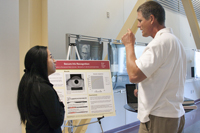 Biometrics is a major class of approaches for user authentication. This project uses iris recognition as a demonstrating example to explore techniques for building secure biometrics systems. After segmenting and identifying the region of the iris, unique and robust features of each person's iris are extracted and used to match with iris patterns in a database. In order to provide privacy protection and deter unauthorized use of sensitive biometric data, iris features should be properly encrypted by jointly employing cryptography, signal processing, and coding. This project examines several encryption techniques suitable for secure and robust biometric matching, and compares their performance. Biometrics is a major class of approaches for user authentication. This project uses iris recognition as a demonstrating example to explore techniques for building secure biometrics systems. After segmenting and identifying the region of the iris, unique and robust features of each person's iris are extracted and used to match with iris patterns in a database. In order to provide privacy protection and deter unauthorized use of sensitive biometric data, iris features should be properly encrypted by jointly employing cryptography, signal processing, and coding. This project examines several encryption techniques suitable for secure and robust biometric matching, and compares their performance.
Presentation Slides
Project Poster
Technical Report
|
|
|
|
|
Low Power Pulse-Based Communication
Santiago L. Bortman (University of Maryland at College Park)
Paresa Modarres (University of Florida)
Mentors:
Prof. Pamela Abshire (UMCP),
Prof. Timothy Horiuchi (UMCP),
David Sander (UMCP),
Timir Datta (UMCP), and
Anshu Sarje (UMCP),
 In an effort to develop small, autonomous micro-robots it is important to minimize power in all system components, including communication. With this objective in mind, we are designing a pulse-based communication system. Transmitting a pre-determined sequence of pulses corresponding to every binary one or zero enables the receiver to identify the transmitted sequence and recover the data in spite of noise. This approach completely eliminates the need for an RF carrier, so the transmitter uses almost no power when idle. The overall system implementation includes a pattern generator and a pulse generator for the transmitter and a RAKE receiver for pattern recognition and data recovery. Our goal is to design and build the transmitter and receiver using discrete components as a proof of concept. In an effort to develop small, autonomous micro-robots it is important to minimize power in all system components, including communication. With this objective in mind, we are designing a pulse-based communication system. Transmitting a pre-determined sequence of pulses corresponding to every binary one or zero enables the receiver to identify the transmitted sequence and recover the data in spite of noise. This approach completely eliminates the need for an RF carrier, so the transmitter uses almost no power when idle. The overall system implementation includes a pattern generator and a pulse generator for the transmitter and a RAKE receiver for pattern recognition and data recovery. Our goal is to design and build the transmitter and receiver using discrete components as a proof of concept.
Presentation Slides
Project Poster
Technical Report
|
|
|
|
|
Bat-Inspired Robot Navigation Using Echolocation
Michael J. Kuhlman (Rensselaer Polytechnic Institute)
Katherine McRoberts (Grove City College)
Mentors:
Prof. Timothy Horiuchi (UMCP),
Prof. P.S. Krishnaprasad (UMCP),
Graham Alldredgeo (UMCP),
Chetan Bansal (UMCP), and
Matteo Mischiati (UMCP)
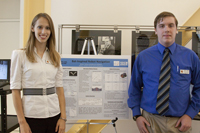 A key objective of Robotics is the autonomous navigation of mobile robots through an obstacle field. Inspired by echolocating bats, we developed a two-part navigation system consisting of obstacle detection through echolocation and motion planninystem, which emits ultrasonic pulses and then determines the interaurag. The first part relies upon a binaural sonar sl level difference (ILD) of the returning echoes to infer obstacle locations. Next, the Openspace motion planner computes the best direction of travel based on the locations of the target and the detected obstacles. We implemented this navigation system on a mobile platform, which repeatedly computes the safest direction of travel and moves accordingly, ultimately generating a real-time path to the goal. A key objective of Robotics is the autonomous navigation of mobile robots through an obstacle field. Inspired by echolocating bats, we developed a two-part navigation system consisting of obstacle detection through echolocation and motion planninystem, which emits ultrasonic pulses and then determines the interaurag. The first part relies upon a binaural sonar sl level difference (ILD) of the returning echoes to infer obstacle locations. Next, the Openspace motion planner computes the best direction of travel based on the locations of the target and the detected obstacles. We implemented this navigation system on a mobile platform, which repeatedly computes the safest direction of travel and moves accordingly, ultimately generating a real-time path to the goal.
Presentation Slides
Project Poster
Technical Report
|
|
|
|
|
Micro-Robot Control and Coordination
John Andrew Turner (University of Maryland, College Park)
Ashia Wilson (Harvard University)
Mentors:
Prof. Pamela Abshire (UMCP),
Prof. Nuno Martins (UMCP) and
Timir Datta (UMCP)
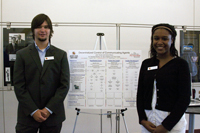 Existing distributed algorithms - for the control and coordination of multi-vehicle systems - assume that each agent possesses unlimited sensing and mobility capabilities. In contrast to prior work, here we focus on the design of distributed coordination algorithms for ant-sized robots that will not possess the sensing and movement capabilities of the existing full-scale ones. Our project also involves the creation of a modular simulation environment, which will be useful as a design aid since it can be used to test the functionality of new algorithms. We are coordinating with other groups at UMD who are working on the fabrication of ant-sized robots, and will assist them in determining what kinds of sensing and communication will be necessary to achieve coordinated movement. Existing distributed algorithms - for the control and coordination of multi-vehicle systems - assume that each agent possesses unlimited sensing and mobility capabilities. In contrast to prior work, here we focus on the design of distributed coordination algorithms for ant-sized robots that will not possess the sensing and movement capabilities of the existing full-scale ones. Our project also involves the creation of a modular simulation environment, which will be useful as a design aid since it can be used to test the functionality of new algorithms. We are coordinating with other groups at UMD who are working on the fabrication of ant-sized robots, and will assist them in determining what kinds of sensing and communication will be necessary to achieve coordinated movement.
Presentation Slides
Project Poster
Technical Report
|
|
|
|
|
The Loss Mechanism of Nanoporous Silicon Optical Waveguide for Biochemical Sensors
Susan Yan (Mount Holyoke College)
Mentors:
Prof. Tom Murphy(UMCP),
Shu Zee Alencious Lo (UMCP), and
Paveen Apiratikul (UMCP)
 Nanoporous silicon waveguides are fabricated by electrochemical anodization in HF solution and laser local oxidation to form a two dimensional guiding structure. The resulting device is characterized using fiber coupling cutback techniques to determine their suitability for biodetection. Previous research has focused on simple linear waveguides, which exhibit high loss and unpredictable optical properties when exposed to biological agents. In this project, we extend the design to more complex interferometer structures in order to pinpoint the effect of surface molecular binding on the material’s optical behavior. Nanoporous silicon waveguides are fabricated by electrochemical anodization in HF solution and laser local oxidation to form a two dimensional guiding structure. The resulting device is characterized using fiber coupling cutback techniques to determine their suitability for biodetection. Previous research has focused on simple linear waveguides, which exhibit high loss and unpredictable optical properties when exposed to biological agents. In this project, we extend the design to more complex interferometer structures in order to pinpoint the effect of surface molecular binding on the material’s optical behavior.
Presentation Slides
Project Poster
Technical Report
|
|
|
| |
|
|
|
|
|









